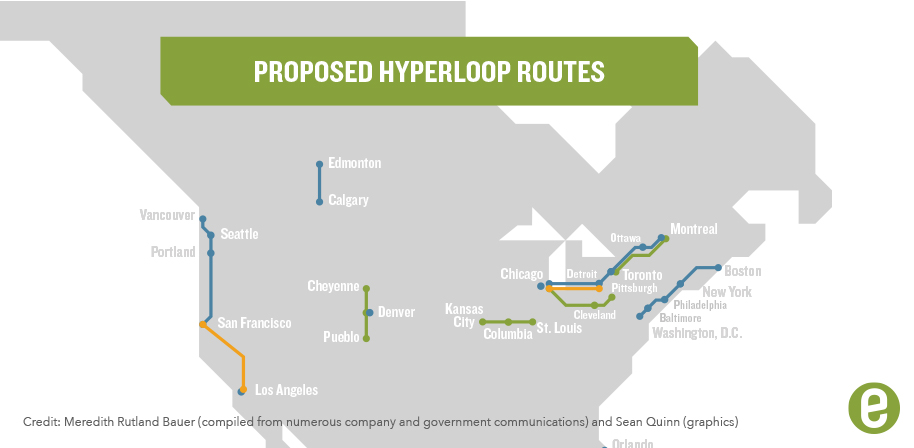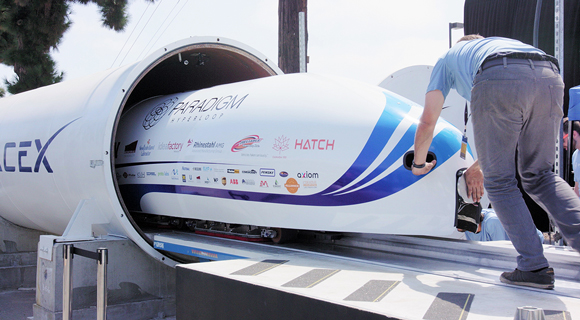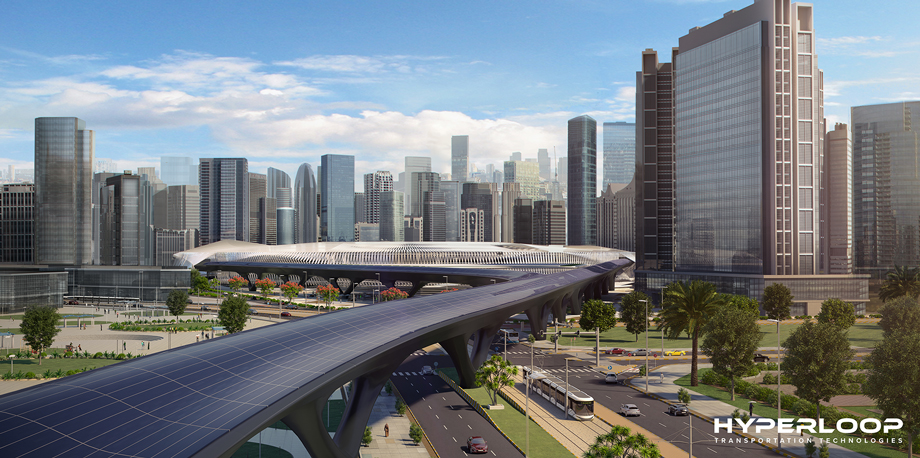December 12, 2018 — Deep in the heart of steel country on a balmy September morning, Cleveland City Council members, professors and non-profit leaders hopped out of their cars and Ubers and filed into a conference hall to find out why an Ohio transportation agency had taken the unusual step of using public money to pursue an experimental form of electric transportation: hyperloop.
Attendees to this transportation workshop were no stranger to new technologies, especially innovations they hoped would make transportation faster and simpler. The Northeast Ohio Areawide Coordinating Agency (NOACA) is part of a “smart city” group already working on adding “internet of things” devices to traffic signals, message signs and traffic cameras in Cleveland and the surrounding region, and Ohio Gov. John Kasich broke ground on a self-driving car test facility in Logan County in July.
But hyperloop was another level of innovation for this corner of the Great Lakes region. The ultra-fast, electric-powered transportation technology, still in the research and development stage, is expected by proponents to propel levitating pods full of people and cargo at speeds of up to 750 miles (1,207 kilometers) per hour in a vacuum tube between metropolises.
Bel Air billionaire and Tesla co-founder Elon Musk popularized the concept with a 2013 white paper that invigorated transportation-minded entrepreneurs. But Musk didn’t lead the charge on hyperloop. Instead, it has been developed and tested by high-tech engineers who joined new companies that were spun up by Silicon Valley and Los Angeles entrepreneurs. Many of these early employees previously spent their careers making spaceships and airplanes fly.

Companies and governments have proposed dozens of hyperloop routes around the world. Click to see complete infographic.
Much as air travel had a period of turbulence before the public could embrace it, hyperloop will likely face its own growing pains, especially in the U.S. The complications of regulating an industry that doesn’t neatly fit into an existing transportation niche, questions of economic viability, pushback from media commentators that hyperloop is more “hype” than reality, and uncertainty related to insuring any high-speed transit could hinder the technology’s progress.
Despite the unknowns, NOACA partnered in February with Hyperloop Transportation Technologies to map out a Cleveland-to-Chicago hyperloop route. The agency spent US$600,000 on a feasibility study that includes a look at the environmental impact of such a route, along with research on engineering feasibility and public outreach. Hyperloop Transportation Technologies contributed about US$600,000 toward that study.
The Ohio agency is hardly alone in its choice to pursue hyperloop. At least 15 routes are proposed for the U.S., and several companies are planning dozens of routes internationally. Virgin Hyperloop One announced results of the nation’s first hyperloop feasibility study in October for a Missouri route, and the company announced it is also involved in a US$2.5 million environmental impact study for a route to connect Chicago, Columbus and Pittsburgh.
The biggest questions surrounding hyperloop’s environmental impact are its effect on carbon dioxide emissions, the effect of infrastructure on ecosystems, and the environmental footprint of the materials used to build it. Hyperloop supporters claim multiple benefits for the technology. As it moves closer to fruition, with companies aiming to have systems ready for people and cargo in the 2020s, this is a good time to ask: How will hyperloop routes affect the environment?
The biggest questions surrounding hyperloop’s environmental impact are its effect on carbon dioxide emissions, the effect of infrastructure on ecosystems, and the environmental footprint of the materials used to build it. Other concerns include noise pollution and how to repurpose hyperloop tubes and tunnels at the end of their lifespan.
Energy and Climate Edge
Steve Carden, transport innovation lead at PA Consulting Group in the United Kingdom, wrote in a blog post for Los Angeles–based Virgin Hyperloop One in 2017 that the vacuum environment will give hyperloop an energy edge over other forms of transportation.

As this entry from the SpaceX Hyperloop Pod Competition shows, tubes and capsules are designed to boost energy efficiency by minimizing drag. Photo courtesy of SpaceX Hyperloop, from Flickr, licensed under CC BY-NC-ND 2.0
“The challenges of electrification [of transportation] are not insignificant, especially in long distance, high-speed travel. Yet, this is where hyperloop has the potential to be a game changer. Imagine traveling at the speed of a jet plane, with the grid distribution efficiency of a train, and almost no aerodynamic drag,” he wrote.
Virgin Hyperloop One estimates worldwide flights alone produced 859 million metric tons (946 million tons) of CO2 in 2017. The company estimates it would be possible to reduce fossil fuel emissions from flying by 58 percent if every passenger flight between 500 kilometers and 1,500 kilometers (about 310 miles and 930 miles) worldwide were replaced with hyperloop run off renewable electricity, says Virgin Hyperloop One spokesperson Marcia Christoff.
The goal, says Kristen Hammer, materials engineering manager at Virgin Hyperloop One, is to run hyperloop exclusively on renewable electricity.
“There’s no world in where we have to cause pollution. It can be run off of all sorts of sustainable energy.” – Kristen Hammer“We don’t want to be chugging smoke into the air or causing pollution,” she says. “There’s no world in where we have to cause pollution. It can be run off of all sorts of sustainable energy.”
Jacqueline Jenkins, associate professor of civil and environmental engineering at Cleveland State University, says renewable energy will have to be an essential part of any new regional transportation system if it’s going to be worth investing any public funding. She says new systems have to be built not only for today’s transit needs, but also to address climate concerns.
“If we don’t do it sustainably, it’s probably a short-term solution,” she says.
Technical University of Munich student Gabriele Semino, team manager for his university’s team in the SpaceX semi-annual hyperloop pod competition, says young engineers aren’t even considering fossil fuels as an option when designing their systems. The university’s team, formerly called WARR Hyperloop but now renamed to TUM Hyperloop, currently holds the competition’s speed record of 284 miles per hour (457 kilometers per hour). Some students from various teams have gone to spin off their own hyperloop companies, while others have been hired by larger hyperloop and space-focused organizations.
“We always want your system to be efficient. We’re at a point in time where everyone in some way or another is focused on being cleaner and more efficient,” says Semino, who is pursuing a graduate degree in physics. “We know the problems burning fossil fuels are generating.”
Dirk Ahlborn, CEO of Hyperloop Transportation Technologies, based in Culver City, California, says solar panels could be placed along hyperloop tubes or elevated routes. He says his company plans to find ways to add in renewable energy wherever possible, such as using the speeding train to produce energy through regenerative braking and adding wind turbines on unused land. The goal, he says, is to produce more energy than needed so the system can feed electricity back into nearby grids.
Minimizing the Footprint
Hyperloop systems will include a hollow tube with a roughly 30-meter-long pod inside, and the tube will be held in the air on concrete columns. According to Ahlborn, these routes will run linearly between cities and end at stations, where engineers envision pods arriving and leaving every minute or so.
Several hyperloop companies are considering ways to build elevated tracks in highway medians and next to existing railroad tracks to minimize the impact construction might have on ecosystems and natural spaces, Hammer says.

Plans to elevate hyperloop tubes and co-locate them with roadways could help minimize adverse impacts on land and wildlife. Photo courtesy of Hyperloop One
Hyperloop tubes between cities will likely stand dozens of feet above the ground on pylons to avoid interfering with power lines or highway overpasses, she says. Since hyperloop is mostly building upward, it can double up on land that’s already being used for other purposes, such as highway medians or abandoned canals.
“If we’re elevated on columns, we’re not really taking up land space, necessarily,” Hammer says. “From a wildlife aspect, we don’t have wildlife trying to cross a freeway or cross a railway because they can go under it.”
However, in cities, tunneling will likely be necessary because building a tube into an urban center would cause social problems by requiring the company to knock down existing infrastructure to make room, she says.
Tunneling opens up a host of environmental questions. Tim Lipman, co-director of the Transportation Sustainability Research Center at University of California, Berkeley, says environmental impact reports will address questions about ground stability, the effect of tunneling on aquifers and whether there are any hazardous chemicals that could leach and spread when the ground is agitated. Hammer said Virgin Hyperloop One’s tunneling team is working on those considerations as the company moves forward.
Musk’s The Boring Company aims to build a tunnel between New York City and Washington, D.C., for a hyperloop route or an automatic car-moving system the company has dubbed “loop.” Currently, the company only has authorization to begin construction on a D.C. building that could become a hyperloop station. The Boring Company did not respond to requests for comment on this piece.
Material Matters
The materials used to construct a hyperloop system are also a factor. A lightweight pod will be suspended in the hyperloop tube, which has a near-vacuum environment to cut down on air resistance. High-powered magnets arranged in a special configuration keep the pod levitating, and a propulsion system at each station gives the pods their initial “kick,” with boosters helping as needed along the way. Batteries positioned at propulsion sites would provide electricity at night when solar panels aren’t making any juice.
One challenge will be sourcing magnets from ethical and environmentally sustainable sources. Hammer said one challenge will be sourcing magnets from ethical and environmentally sustainable sources. The powerful magnets hyperloop uses require traces of rare-earth elements. Some strong rare-earth magnets use neodymium or samarium, which are significantly more powerful but more expensive than other permanent magnets made from iron ore, cobalt and nickle. Cobalt, which is combined with samarium to create a supermagnet, presents its own challenges given that cobalt mining relies on child labor, according to reports by UNICEF and Amnesty International. Mining is also suspected to have serious environmental and health consequences for those miners.
Access to the materials for better, stronger batteries will be critical for hyperloop’s success — at least if it’s going to run completely off renewable energy, Ahlborn says. Lithium-ion batteries have been declining in price and increasing in capacity over the past decade, and the global market for lithium-ion storage units is predicted to increase by 12.1 percent from 2018 to 2024, according to a recent report from Infinium Global Research. Yet lithium itself comes with environmental challenges that the renewables industry is beginning to acknowledge.
Ahlborn said the concrete needed to construct the hyperloop infrastructure poses another environmental challenge. Concrete will likely be used for the pylons that hold up hyperloop tubes, as well as hyperloop stations, parking garages and other run-of-the-mill infrastructure.
“But you have to look into this,” he says. “We question literally everything. … You have to think about how you construct, how you build, how materials are constructed, are there alternatives to concrete? We all have a responsibility because we’re here for a limited amount of time. Sustainability has to be a part of our daily lives.”
A request to Hyperloop Transportation Technologies to get more information on the sourcing for the proprietary composite material for its pods — a carbon fiber material that the company claims is stronger than steel alternatives and aluminum — wasn’t returned by press time.
Noise and More
Noise is another potential concern. However, tests of early-stage pods by companies and student enthusiasts suggest a hyperloop system would make less noise than a highway. In fact, when the first hyperloop pods ran in a semiannual student competition held by SpaceX on a half-size system in Los Angeles in 2017, the pod’s “woosh” sound was dampened by the surrounding tube, then drowned out by cheers.
Hammer said her team is working on figuring out how to design hyperloop tubes and systems so they don’t degrade and become the next generation’s abandoned rail lines. Regarding long-term materials management, Hammer said her team is working on figuring out how to design hyperloop tubes and systems so they don’t degrade and become the next generation’s abandoned rail lines. “We’re not just here to build this cool thing and throw it out in the world,” she says. “We’re trying to design our system so that it ages gracefully.”
The two largest players in the hyperloop space, Virgin Hyperloop One and Hyperloop Transportation Technologies, say they’re creating sustainability procedures for their routes, such as limiting the amount of demolition needed and using existing infrastructure and rights-of-way when possible. While details about which federal agency will regulate hyperloop in the U.S. are still being determined, several environmental impact reports are going forward to determine whether proposed projects will violate local, state or federal environmental laws and assess other impacts to cities, agriculture, ecosystems or watersheds, says UC-Berkeley’s Lipman.
He added any environmental impact reports completed on prospective hyperloop routes will vary in depth depending on whether the project is state funded or federal dollars are involved. For example, an impact study done on a federally funded project must include notes about Clean Air Act and Clean Water Act requirements, whereas some regionally funded projects might not look specifically into those laws. An environmental impact study provides guidance about how to avoid such issues or minimize them, and it also provides the public with information about potential risks a project might pose.
Back to the Future
Back in Cleveland, Ahlborn used his keynote speech to address the concerns plastered on attendees’ faces. Was hyperloop scientifically possible? How could it be profitable? And why should a region invest in an undeveloped technology when their existing transportation systems need upgrades?
“If someone says something can’t be done, it just means they haven’t figured out how to do it yet.” “There’s actually no rail, no major one in the world, that is profitable. They all rely heavily on government subsidies,” he told the crowd of about 350 people. Hyperloop, he said, would be different. “If someone says something can’t be done, it just means they haven’t figured out how to do it yet.”
Grace Gallucci, executive director of NOACA, says while she believes hyperloop will be an environmentally sustainable option, it’ll be helpful to have information on any negative environmental impacts to help avoid or mitigate them. She says the transportation sector as a whole seems intrigued by the lure of hyperloop’s Jetson-like image of the future, but few groups have been willing to take the financial leap because the technology hasn’t been tried commercially yet — an early adopter’s catch-22. She’s hoping the Great Lakes area will get an economic boost by taking that chance, but only if the region can do it in an environmentally friendly and socially equitable way. The agency’s feasibility study is expected to be completed by an independent analysis firm in early 2019.
“A lot of this is new to us,” she says, “and we don’t really have answers.” ![]()
UPDATED 12.14.18: The contributions of NOACA and HTT to study a Cleveland-to-Chicago hyperloop route were updated to US$600,000 each.
Related Posts
Ensia shares solutions-focused stories free of charge through our online magazine and partner media. That means audiences around the world have ready access to stories that can — and do — help them shape a better future. If you value our work, please show your support today.
Yes, I'll support Ensia!





mitigate damage to the environment and protect animals; plus, being made from
less toxic materials. But my concern is how this type of travel impacts one's health? I would want an answer to that before seeing cities jump into this configuration. May be it is quite okay to travel at high speeds in a tube! Guess we'll know when we know.